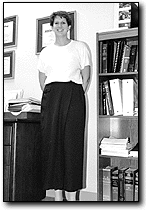![[ NEWS ]](/images/fall97/newsf97.gif)
Arizona Summer Wildcat July 22, 1998
Stories behind the statistics
![[Picture]](01_1_i.gif)
|
Tanith L. Balaban
Diana Stapleton waitresses at the Blue Willow after graduating in 1997 from the UA with a fine arts degree.
|
Arizona Summer Wildcat
Claire Lauer tucked her chin-length hair behind her ear and adjusted her cardigan.
She has always put pressure on herself.
"If I want to compete with the boys, I have to work harder," she said, folding her hands and leaning forward.
Lauer, who earned her University of Arizona bachelor's degree in May, is one of thousands of American women who tipped the scales and put women's college graduation rates higher than men's.
The U.S. Census Bureau reported in June that more women than men, between ages 25 and 29, graduated from college in 1997. The report, "Educational Attainment in the United States," shows that 29.3 percent of women hold undergraduate degrees, compared to 26.3 percent of men.
"It's a very small difference, but it's significant," said the report's author, Jennifer Day, from her Maryland office. "It's the very first time we're seeing women pull ahead."
Day said men led the college field from the 1940s until 1986, when the numbers of men and women earning undergraduate degrees hit an even plane.
UA women have surpassed male undergraduates by nearly 75 degrees as far back as four years ago. In 1996, 74 more women than men left the UA with diplomas.
In 1997, however, the gender margin increased more than threefold, landing women with 275 more degrees than men. There are also more women in the general student body, with a ratio of 51-to-49.
Lauer said she sees a difference between the attitudes of men and women reflected in the graduation rate.
"I think what it comes down to is that women have come to realize we can't depend on anyone to get what we want," she said.

Pam Garfinkel, who graduated from the UA in May with a psychology degree, now answers phones at Haemonetics Blood Services and Training Institute Inc. Garfinkel said she plans to pursue a dental career.
Pam Garfinkel put on her headset and spun a half-circle to face a stack of files. As a receptionist at Haemonetics Blood Services and Training Institute, Inc., she said she does "everything everyone else doesn't want to do."
Garfinkel graduated with a UA psychology degree in May, and found her job as a receptionist a month-and-a-half ago. She laughed as she said she didn't plan to use her undergraduate degree, but will go on to graduate school.
Census report author Day, however, wasn't laughing.
"You're still going to see very different career paths between men and women," she said.
UA women continue to graduate with more undergraduate education, language and social science degrees than men, while men lead in the hard sciences, business and computer science.
Day said this contributes to the income gap between men and women.
The College of Education had 595 women and 172 men in its program for the 1997-98 school year. Jane Cox, UA Dean's Office education specialist, was not sure why men were in the minority.
"The only explanation I can think of for that is that more women (than men) are interested in becoming teachers," she said.
The average starting salary for a teacher with an undergraduate degree in the Tucson Unified School District is $21,750.
Edmund Tellez, UA director of the minority engineering program, said the average starting salary for workers with undergraduate engineering degrees is around $35,000 to $45,000.
But women largely are not interested in becoming engineers, he said.
The College of Engineering and Mines had 2,002 males enrolled and 382 females enrolled in 1997-98.
Tellez said the number of women enrolled in the engineering college has not increased significantly over the past few years.
"Once they (women) get into an engineering class where there are five young women and 25 young men, that could be intimidating - just sheer numbers," he said.
He added that the lack of female UA engineering professors leaves women without role models on campus.

Jeanette Baldwin graduated in '96 with a degree in studio arts photography. She now works at Centric Photo Processing and has started her own business photographing weddings and taking portraits.
Anne Kyl could be a role model.
A UA College of Law diploma reflects the view from a large bay window in her office. She has a job at Brown and Bain, a Tucson law firm where the starting salary is $60,000.
She didn't start at the top. The daughter-in-law of U.S. Sen. Jon Kyl, R-Ariz., found out she was "the world's worst legal secretary" after her first job out of college as a U.S. Supreme Court clerk.
"I had to go to law school," she said.
But many women don't make it as far as Kyl.
UA women earned 250 more master's degrees than men out of a total of 1,346 at the UA, according to 1997 statistics. Women have excelled in pharmacy and medicine during the past few years, and 53 women and 40 men graduated from the UA College of Medicine in 1997.
But women did not go on to earn as many doctorate or law degrees.
Kyl said the law college is trying to improve the balance between men and women.
"The last four or five professors hired have been women, but the law college is not perfectly balanced," she said.

A '96 graduate from the UA Law School, Anne Kyl is now a lawyer at Brown and Bain in Tucson. Her first job out of college was as a legal secretary for the U.S. Supreme Court.
Sharon Kha also watches closely. She's been at the UA for 14 years, and she says she's seen a lot of UA "firsts" and has experienced some herself. She's among the first women to sit on the presidential cabinet, and is the first female director of UA News Services.
She saw the first female dean of students take office and was working at the UA when the first woman rose through the ranks to vice president.
"In the last 12 years alone, I've seen a lot of women move into administration," she said. In the fall of 1998, there were 39 male executive administrators and 23 females.
But she's never seen a female UA president.
"I would say that if there's a (glass) ceiling, it's between the president and provost," Kha said.
While women are ascending the ranks of the administration, there is not the same trend for academic leadership.
The ratio of male to female department heads was 10-to-1 for 1997-98, and there were twice as many male professors as females.
"There hasn't been a good record of women following the academic pipeline," Kha said. She said women sometimes wait to come into the academic realm until later in life, therefore having fewer opportunities to lead.

Since graduation in May, Claire Lauer has been working at the Arizona Bank with the Construction and Lending Department. She is going to graduate school at the UA and will be a teaching assistant for rhetoric and composition classes in the fall.
But recent UA grad Lauer has her mind set. She leaned back in her chair.
She said she's going back to the UA to get a graduate degree in English.
"I see college as the road to getting what I want," Lauer said. "It's only going to get harder."
|
|
|||
| Year | Males | Females | Difference |
| 1993-1994 | 3,391 | 3,465 | 74 |
| 1994-1995 | 3,390 | 3,462 | 72 |
| 1995-1996 | 3,312 | 3,368 | 56 |
| 1996-1997 | 3,275 | 3,612 | 337 |
|
|
|||
|
|
||
| 1995-1996 | Female | Male |
| Bachelor's | 2,330 | 2,282 |
| Master's | 752 | 626 |
| Doctorate | 126 | 258 |
| Pharmacy | 30 | 18 |
| Medicine | 56 | 42 |
| Law | 86 | 84 |
| Total | 3,386 | 3,312 |
| 1996-1997 | Female | Male |
| Bachelor's | 2,526 | 2,251 |
| Master's | 751 | 595 |
| Doctorate | 170 | 275 |
| Pharmacy | 32 | 19 |
| Medicine | 53 | 40 |
| Law | 77 | 93 |
| Total | 3,612 | 3,275 |



